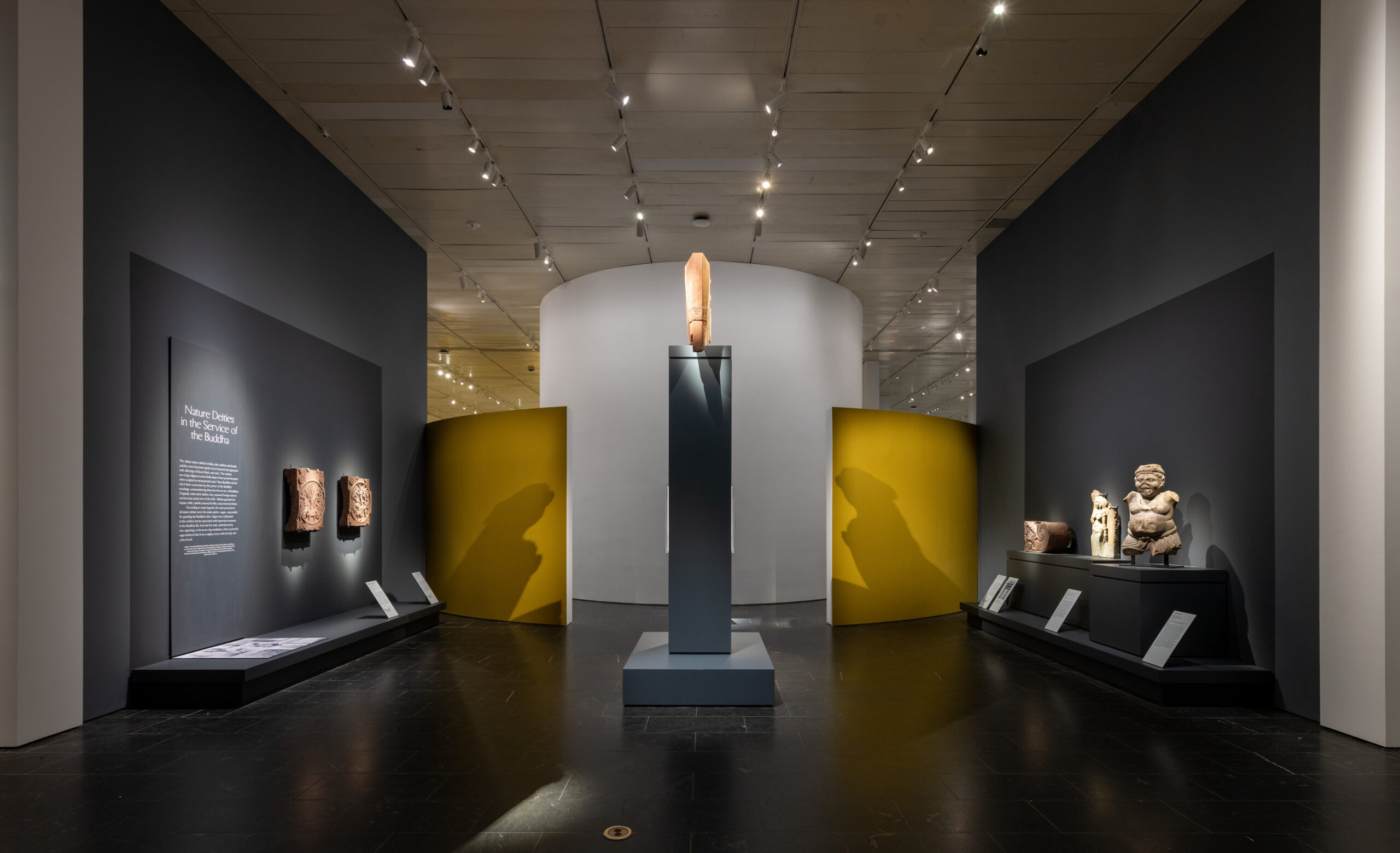
Tree and Serpent exhibit at The Metropolitan Museum of Art in New York City.
When Jinah Kim, LMSAI faculty member and the George P. Bickford Professor of Indian and South Asian Art at Harvard University first toured The Metropolitan Museum of Art’s new exhibit, Tree and Serpent: Early Buddhist Art in India, 200 BCE–400 CE, she remarked on its presentation of early Buddhist art, saying, “What makes this exhibition remarkable is the curation and its display strategies; I’ve come to expect a certain grandeur with the Met’s special exhibitions, especially those curated by John [Guy], and this one definitely did not disappoint. The beauty of early stone sculptures is in full view here – and the story it tells of the early Buddhist art as it pertains to the Southern regions of India is crucial yet often overlooked in the general narrative of Buddhist art and of South Asian art. It makes us see the canon of Indian art in a new light (and sometimes it’s quite literally so with incredible lighting!!).”
The exhibit tells the story of early Buddhist art through 125 objects dating from 200 BCE to 400 CE. Conceptualized by John Guy, Florence and Herbert Irving Curator of the Arts of South and Southeast Asia in The Met’s Department of Asian Art, the exhibit was a complex logistical exercise, with major loans—of which many are loaned for the first time—from India, Europe, the United Kingdom and the United States. We spoke with John Guy about the exhibit, and what it took to bring it to the public.
Tree and Serpent Events
September 29 and 30: The exhibit features a two-day symposium, Tree and Serpent: Early Buddhist Art in India and Its Global Reach, which will present new scholarship around the themes explored in the exhibition. Co-sponsored by the Mittal Institute, the symposium is free and open to the public with an advanced registration strongly encouraged.
September 28: On the day prior to the symposium, LMSAI Graduate Student Associate Vaishnavi Patil presents an installment in the “Conversations with … An Expert on Tree and Serpent: Early Buddhist Art in India, 200 BCE–400 CE” series. Vaishnavi, a doctoral candidate at Harvard University in the Department of History of Art and Architecture, is a former research scholar for the exhibition in the Department of Asian Art, The Met.
Mittal Institute: I am curious about the evolution of Tree and Serpent – many of these rare antiquities are on loan from India for the first time, so the logistics must have been complex. You conceptualized the exhibit, which Met Director and CEO Max Hollein says came about through your “resolute commitment.”, What did it take to bring it to fruition?
John Guy: The exhibition came out of a desire to address what I saw as some imbalances in the way that the history of Indian art – and Buddhism, in particular – has been presented in the past.
The exhbition’s formulation essentially started around 2014 when I began periods of field work in southern India, especially in Andhra Pradesh and Telangana. As originally conceived, we were ready to present the exhibition in 2020, but of course, that was put on hold with the pandemic and we came back to it again in 2022.
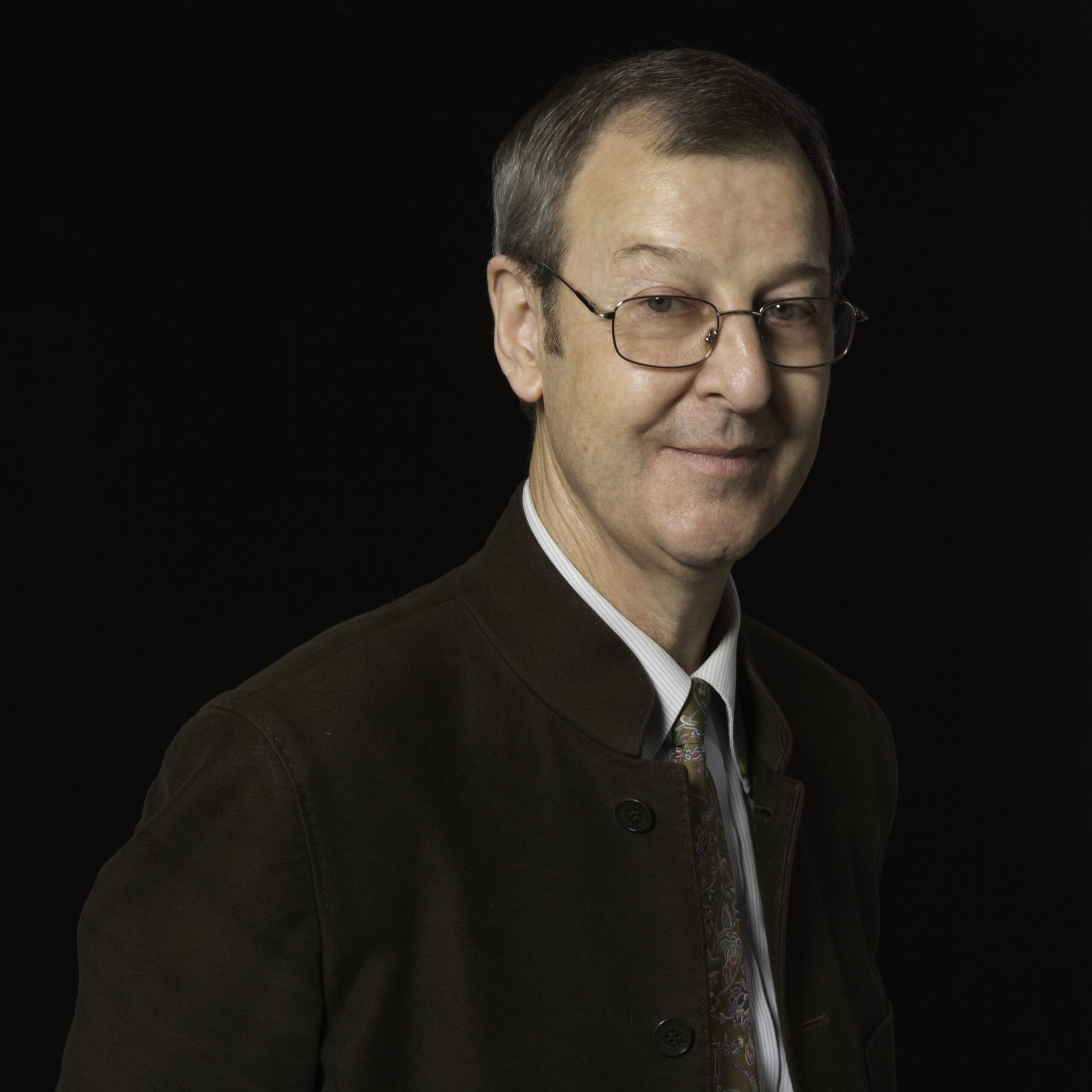
Curator John Guy, Florence and Herbert Irving Curator of the Arts of South and Southeast Asia in The Met’s Department of Asian Art.
We have had remarkably generous cooperation from agencies across India, to whom we’re deeply indebted. The Ministry of Culture of the Government of India has been enormously supportive, along with the National Museum which has acted as the nodal institution for assembling all the loans across India, drawn from twelve locations in seven states. Plus of course the support of the Archaeological Survey of India. In addition to that, we worked with six state governments and their institutions, in the end borrowing from around 12 sites across India. This logistically was a very complicated exercise. We are talking about monumental stone pieces in many cases, so the sheer logistics of this are substantial. We also have additional loans from Europe, the U.K, and the U.S, but the lion’s share comes from India. I think it’s safe to say that this is the largest loan of antiquities from the government of India for a generation.
I think it’s safe to say that this is the largest loan of antiquities from the government of India for a generation.
We were also very honored to have both the Indian ambassador from Washington, D.C, Ambassador T. Sandhu and the U.S ambassador Eric Garcetti from New Delhi both in attendance, standing shoulder to shoulder at the opening ceremony. That was a special moment in US-Indian cultural relations, and for The Met.
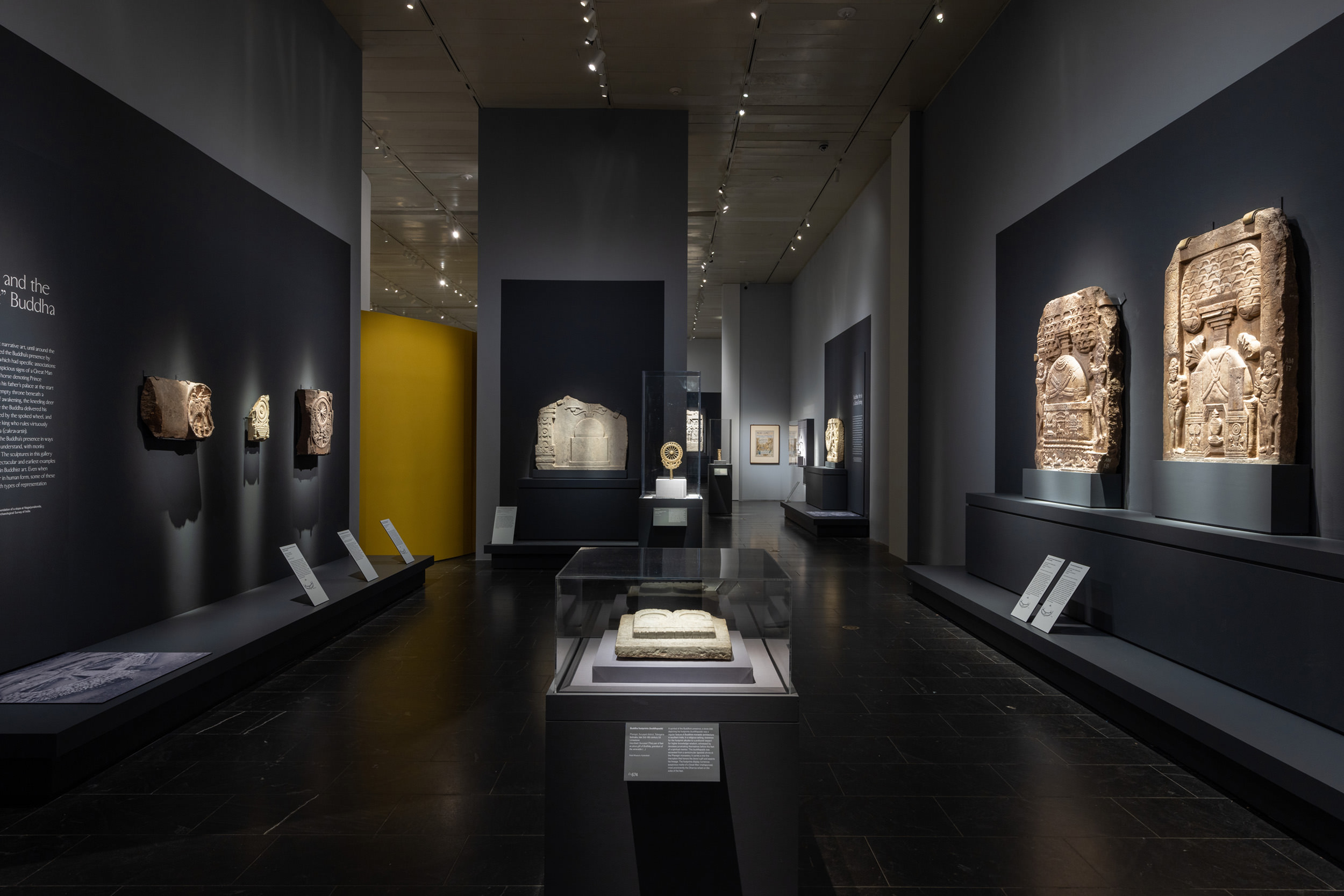

Mittal Institute: Can you talk about why this exhibit was conceptualized, and why is it so important to share the evolution of Buddhist art in India with Met visitors and the American public?
John Guy: It’s well known that the study of Buddhism in India is largely a 19th century phenomenon, that began in the late 18th century, driven largely by Western scholars who studied Sanskrit, and fostered the emergence of the discipline of Indology. They created a vision of Buddhism that is entirely textually-based.. This is largely what’s been inherited into the 20th century by scholars everywhere, including in India. And this has always troubled me, somewhat .There’s now a trend to reflect the reality of early lived Buddhism as best we can deduce it. Re-reading the texts and going back to their original sources and inscriptions is critical, as is looking at additional sources. Particularly, it is important to look at the archeology on the ground, and what that tells us about how Buddhism was practiced in this early period.
The exhibition Tree and Serpent has a narrow time frame, from around 200 BCE through to 400 CE. Further, I’ve purposefully shifted the spotlight away from North India and the standard narrative, which presents Buddhist arts from Mathura to Sarnath to Eastern India and Pala, with a little side trip up to Gandhara in the Peshawar Valley. That’s your standard territory. It is important of course, and remains central to the story of early Buddhist art.
When presenting an exhibition like this, its really got to have multiple narratives. And you have to present it on multiple levels. My first criteria for any exhibition is that the objects must be drop dead beautiful. The aesthetic standard is very high. And aesthetic standard, for me, is far more important than condition. So it could be a fragmentary object, but the quality is breathtaking. This qualifies.
And then you get into the historical importance of the objects: what do they tell us? What messages do they convey? What are the narratives that come from them? Buddhist art is a gift because it’s full of narrative and storytelling. This is how the Buddha taught. He used the medium of storytelling and of dialogue. Most of his teachings, as they’re recorded in the sutras, are in the form of a disciple posing a question, and him responding to the question. That structure is reflected in the art.
Mittal Institute: You reflect that this exhibit could also be called “The Art of the Stupa” – what role do stupas play in the design of the exhibit itself, and why are they so important in Buddhism?
John Guy: Stupas are essentially funerary mounds, pre-Buddhist tumuli that were adapted by Buddhism. The Buddha expressed his wishes that his corporeal remains after his cremation be housed in a stupa, so that he would be buried – in his own words – in the “manner of a king” – a spiritual monarch of course rather than a temporal monarch. And so central to the spread of Buddhism was the construction of stupas and monasteries. A stupa, of course, is not a stand alone monument. It’s part of a monastic complex. But it’s the spiritual heart of the monastery because it signals the presence of the Buddha through the relics which are housed within, and are the focus of daily worship, and remain so to this day.
The division and dispersal of the relics was instrumental in the spread of Buddhism, and ran alongside the growth of the trade routes and mercantile activity between the North and the South, utilizing what they call the Great Southern Highways, the Dakshinapatha, the “roads leading South.” The monasteries and the stupas were located along the great trade routes for a very obvious reason – the mercantile community and the craft guild communities were the principal moneyed patrons of Buddhism. They paid the bill and cut the check for the construction of these very expensive monuments.
The relics and the stupa are really at the heart of Buddhist ritual and Buddhist worship. In the exhibition, we asked the designer Patrick Herron to let us have some sort of conceptual stupa at the physical center of the exhibition. This he realized brilliantly – we have a Great Stupa drum. We constructed the railing, creating the circumambulation path that takes you around to view the extraordinarily rare and important objects within. The Buddha was born at Lumbini in western Nepal today – we have Ashokan inscriptions that tell us that. A stupa at Piprahwa, excavated in 1898 a little south of Lumbini, about 10 or 12 miles, yielded the richest relic offerings recorded in Buddhist India. We display some of these reliquary contents in the exhibition. They lie at the very center of the show. And the exhibition rooms radiate around the stupa, always keeping it – and the relics – at the center of the story. Two reliquaries from the Greater Sanchi area, excavated in the mid 1850s by Alexander Cunningham, the founder of the Archeological Survey of India are also displayed.
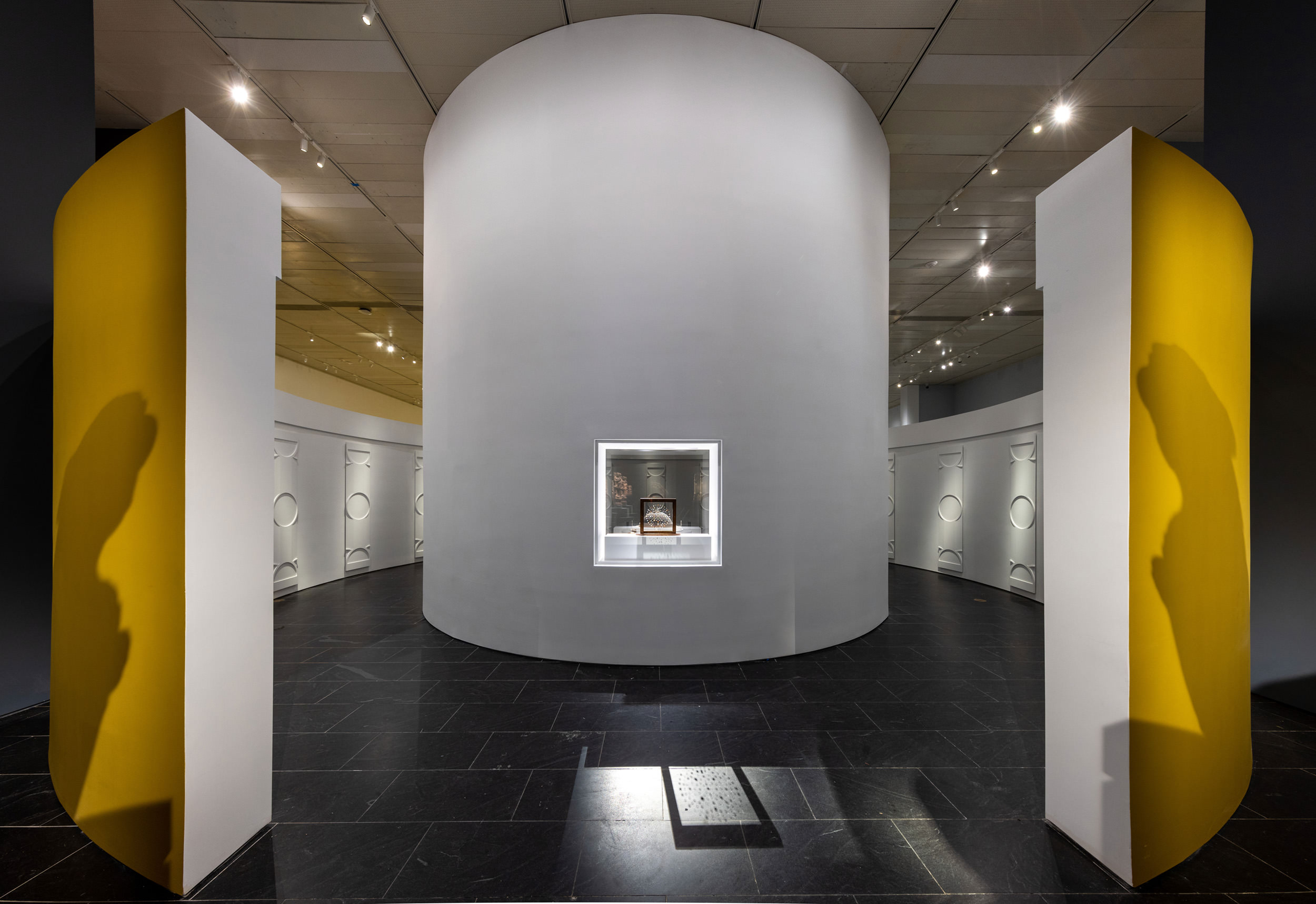
Mittal Institute: There are a number of concepts throughout the exhibit – for instance, visitors may notice that Buddha’s representation evolved from that of symbols in the 1st century CE to that of a human figure in the 3rd century CE. Can you talk about some of the most important themes that visitors can glean from this exhibit?
John Guy: The exhibit takes people through a series of eight rooms, which interlock in various ways. In the exhibition, I thought it would be a wonderful opportunity to present some of the great stories of early Buddhism. You can view the aniconic phase when there’s no representation of the Buddha in human form, but only in symbolic ways, for example by a riderless horse for the great departure, the footprints, the Buddha pada, the wheel of his teachings, and so on. There is also the relic container, and other ways of representing his presence. Then visitors come to the finale in the last room, which was created as an apsidal shrine – there is an apse at one end in which a sublimely beautiful free-standing Buddha is presented.
It’s an unusual Buddhist exhibition in that there are not many Buddhas in it. And some visitors are probably finding that a bit challenging in terms of their preconceptions. But it shows you how we got to the point where the Buddha was represented as a sublimely beautiful human form. And that journey has not been taken before. So in a sense, it’s the first time that there’s been a serious attempt to look at the early indigenous origins of Buddhist imagery, going back to the nature cults of the early rural India, the Yakshas (the tree spirits), the Nagas (the snake spirits). Hence, the title: Tree and Serpent.
And there is also a serious undercurrent in that the Buddha was a pioneer in terms of environmental conservation. There are express Ashokan rock cut and pillar inscriptions in the mid 3rd century BCE, reflecting the ethics of the time: do not burn the forests, do not destroy the environment, do not slaughter certain categories of animals. And so does this relate to environmental concerns today? Of course, it does. There are serious messages to be taken away from Buddhist teachings, which are central to our welfare and our future.
There are serious messages to be taken away from Buddhist teachings, which are central to our welfare and our future.
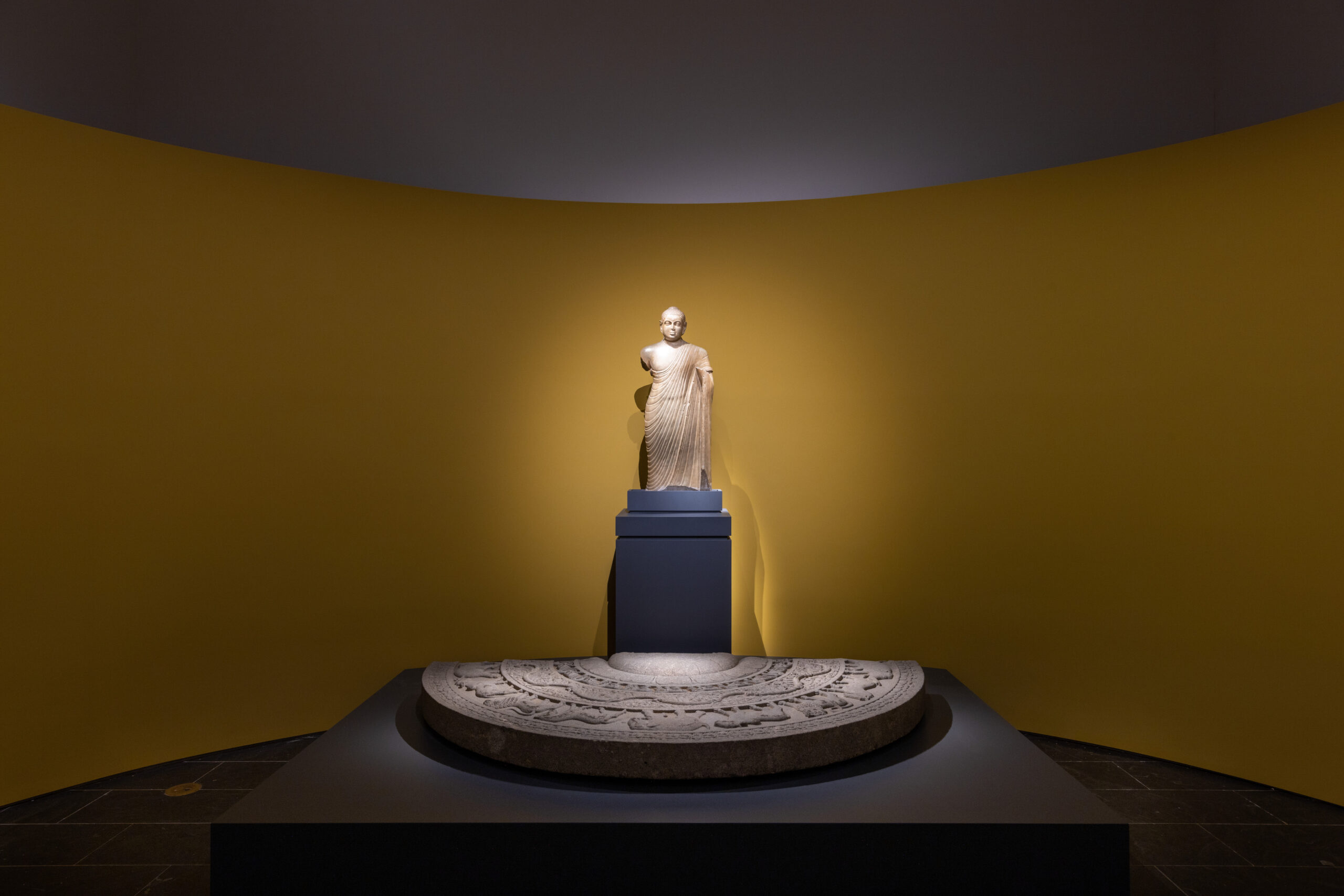
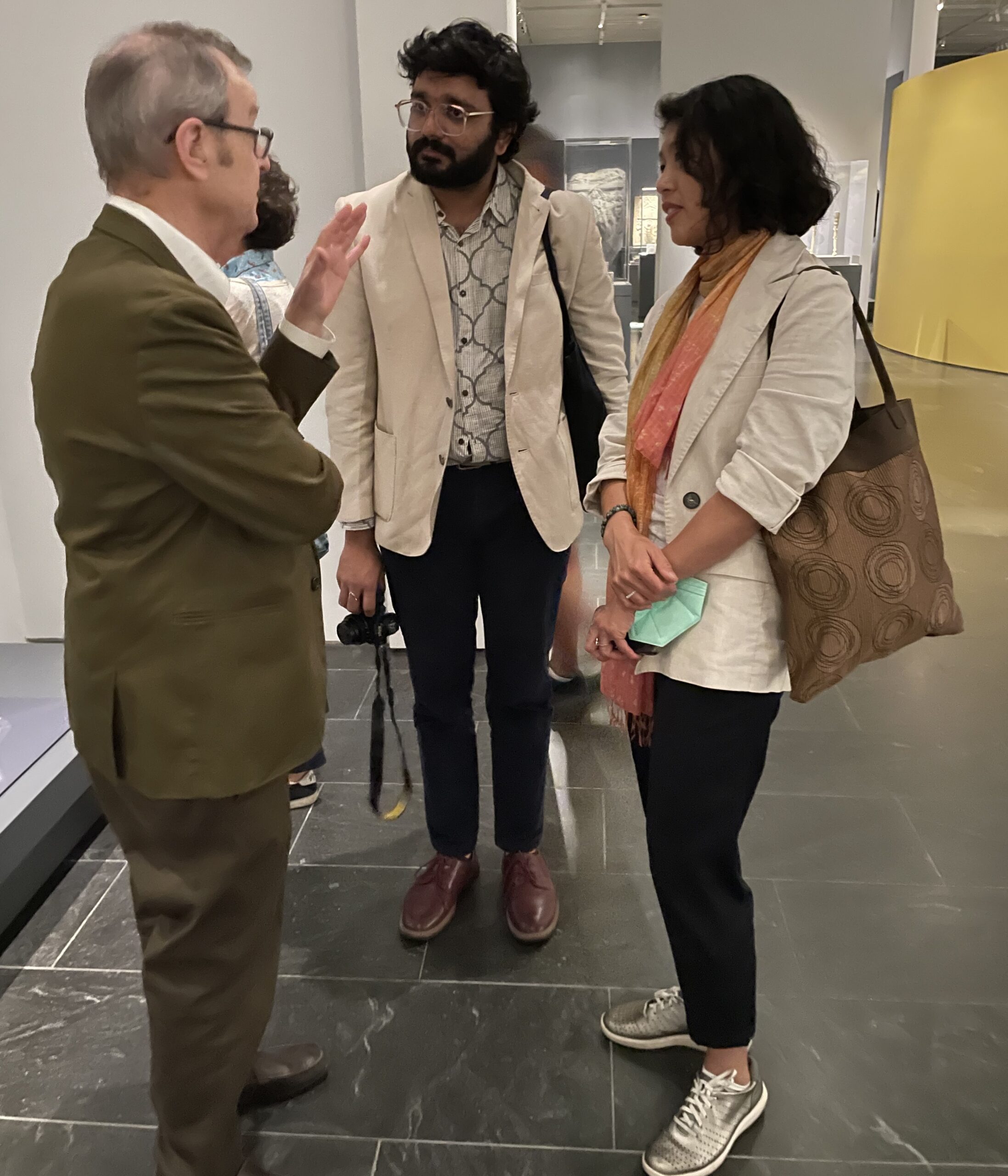
Curator John Guy (left) gives a museum tour to Prof. Jinah Kim (right).
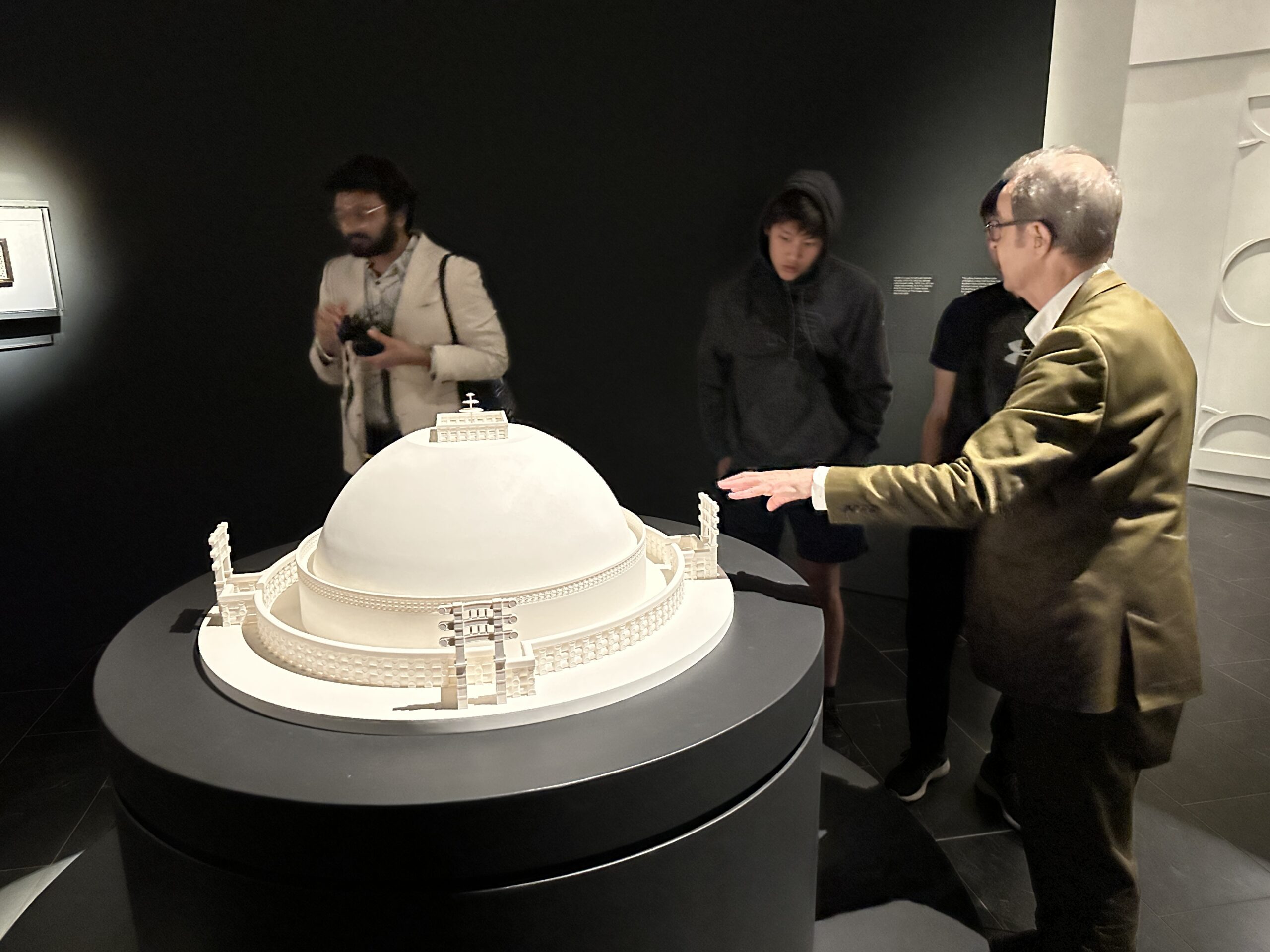
John Guy (right) shows a replica of a stupa.
Mittal Institute: One room is devoted to Buddhist art in a global setting, showcasing two objects that show the connection between South Asia and the Mediterranean – the first, a bronze of Poseidon from the 1st-2nd century CE Alexandria, excavated in West India; and the second, and an ivory standing of a nature spirit – a yakshi – carved in the Deccan and excavated in the ruins of Pompeii, Italy, in 1938. Can you talk about why it was so important to showcase Buddhism’s global reach?
John Guy: India’s always been interconnected throughout its recorded history. In the period we’re exploring, this was the moment of the Roman Empire, and of the Satavahanas, who were a parallel dynasty to the Kushanas in northern India around the 1st century BCE to around the 3rd CE. They controlled the western Coast to the Bay of Bengal on the east. They had all of these connections to maritime trade, with merchants going to Southeast Asia for spices and particularly, for alluvial gold – hence the ancient name of Southeast Asia as the “land of gold” or the Islands of Gold, Suvarnabhumi.
Of course, the Red Sea trade was so important to Alexandria and the Roman Mediterranean. In the exhibition, we have two objects that I’m especially proud of. Both are first time loans. One is a Roman bronze of Poseidon, which was excavated with some other metal Roman luxury items in a small town called Kolhapur, near Pune in Maharashtra, Western India, in 1944.
And then on the flip side of that, we have an extraordinary ivory figurine, in beautiful condition, of a young woman heavily dressed in jewelry and not much else. She’s a nature spirit, a yakshi. We know where she was made in the Deccan. And she was excavated in Pompeii, so sometime before 79 CE, when she was buried with the eruption of Mount Vesuvius. And just these two objects alone, both of which are miniature, encapsulate the whole Indo-Roman trade story.
We know quite a lot about the exchange between Rome and India. It’s well documented, particularly in Roman sources, that the Romans were increasingly concerned about the drain of this trade on Rome’s precious metal reserves.
Mittal Institute: Another component of the exhibit is a public symposium, “Tree and Serpent: Early Buddhist Art in India and Its Global Reach,” slated for September 29 and 30. Can you give us a glimpse into some of the themes the symposium might touch upon, and some scholars we expect to hear from?
John Guy: I think an exhibition like this can be an aspiration. We would hope it will be a catalyst for scholarly focus, as well as popular awareness. In the catalog, we invited a number of international scholars to contribute new cutting-edge material on their research in this field. But of course, there are many other scholars working in this field who could not be included. The intention with the symposium was really to bring in some of these new voices. We have a number of symposium speakers coming from India; others who were contributors to the publication also, but we’re just really widening the scope here. We’ve been very fortunate in the responses we’ve had. A significant number of the key people leading research today in the field of Buddhist studies and Satavahana history will be speaking.
We have 16 speakers plus a keynote address by Gregory Schopen, Distinguished Professor Emeritus of Asian Languages and Cultures, University of California, Los Angeles, who needs no introduction to those in Buddhist studies – he is a major figure of our generation. The two-day program runs on September 29 and 30.
Mittal Institute: What has the partnership with the Mittal Institute and other universities brought to the symposium?
John Guy: While the symposium was organized here at The Met, I was keen that we bring in other partners. We have the Mittal Institute; New York University Global Asia; and the Center for Global Asia at NYU Shanghai. The purpose of that was to widen the exposure of the symposium, and to listen and take advice on what other speakers could be included in the symposium. We had very valuable feedback from our partners on this. Essentially, we endeavored to be a wider church; we wanted to bring in more people to widen the conversation. And bringing in these three academic communities was a way of doing that.
